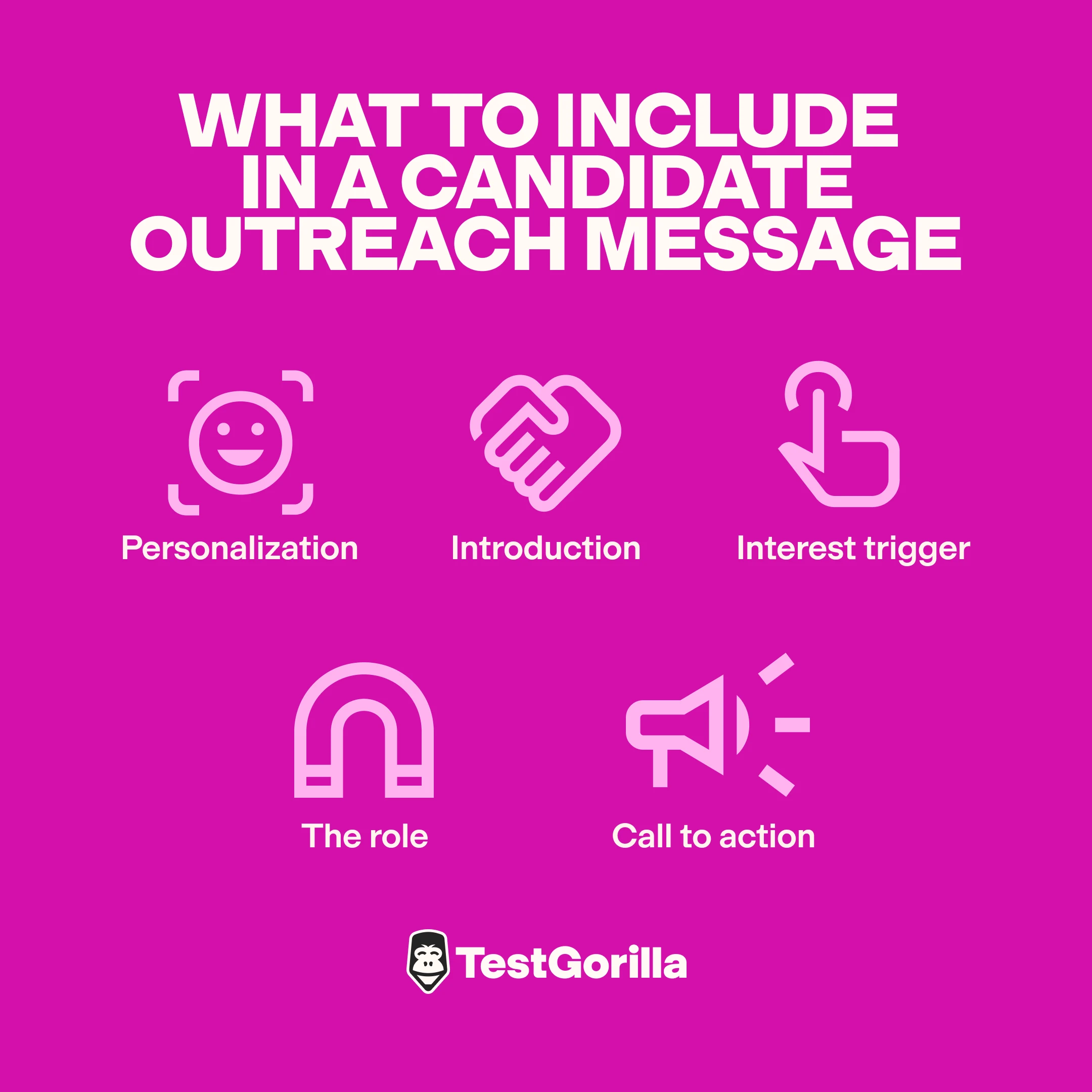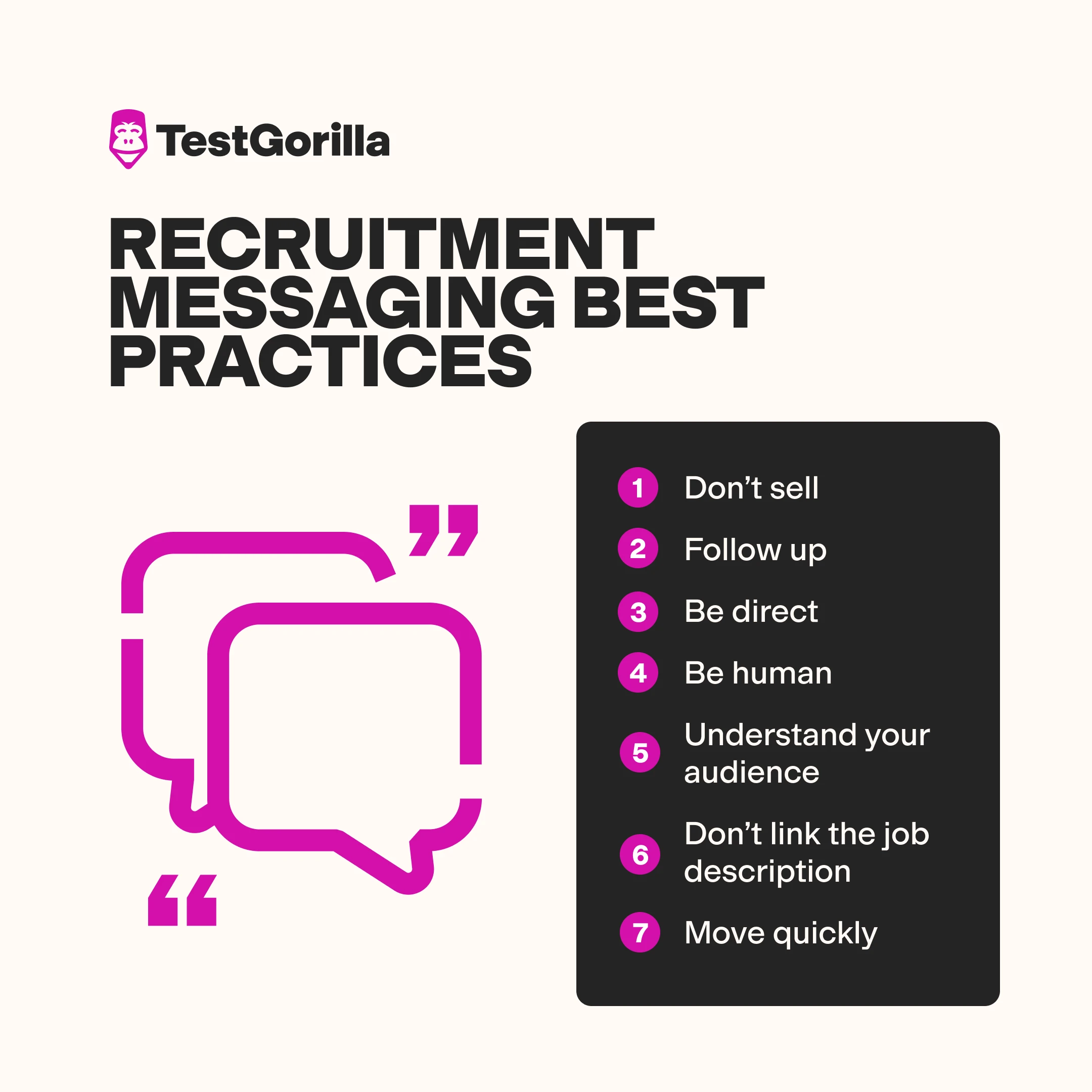Recruitment messages are just like any other two-person conversation.
If you show genuine interest and curiosity in the other person, the conversation will be more rewarding for both of you.
Therefore, an effective recruitment message should make the candidate feel heard and valued. It should make the position seem like a good fit for them.
Many recruiters, however, see recruitment messaging as a numbers game or just another way to automate recruiting ( spam messages, we’re looking at you). If you send enough messages, you’ll eventually catch someone’s attention.
In this guide, we’ll share tips for sending recruitment messages that your target applicants will respond to, including six examples of messages that will help you fill your candidate funnel.
What is a recruitment message?
Recruitment messages are the cold outreach messages recruiters send to potential job candidates to generate interest in vacant job positions.
Although LinkedIn is the most regularly used channel for recruiter outreach, recruitment messages can also be sent via email or social media profiles.
Why targeted recruitment messages are important
A passive recruitment strategy relies heavily on recruitment messages. Passive candidates are those who are currently employed and not actively looking for a new job but might be interested if the right opportunity presents itself.
Passive candidates, according to Glassdoor, are 120% more likely to make an impact in your organization. As a result, recruitment messaging is an excellent strategy for replenishing your candidate pipeline with top talent.
That said, anyone with a LinkedIn profile is well aware of how many recruitment messages end up in their inbox regularly.
As a result, writing personalized, targeted messages is far more likely to pique candidates’ interest than relying on sloppy, copy-pasted templates.
The best insights on HR and recruitment, delivered to your inbox.
Biweekly updates. No spam. Unsubscribe any time.
What to include in a candidate outreach message
There’s no winning formula or perfect template for recruitment messages, but there are some elements that recruiters should include to be effective:
Personalization: Include the candidate’s name and other personally tailored details.
Introduction: Introduce yourself, the company you’re hiring for, and what you’re trying to accomplish.
Interest trigger: Tell the candidate why they caught your attention.
The role: Hook the candidate’s interest by positioning the role enticingly.
Call to action: Give the candidate a simple way to express interest or carry the process forward (e.g., accepting a 15-minute meeting).
However, a compelling recruitment message isn’t just about what you say; it’s also about how you say it.
Recruitment messaging best practices
Here are some recruitment messaging best practices to keep in mind when reaching out to candidates:
Understand your audience: Create an ideal candidate profile and an outreach message that speaks to that audience.
Be human: Conversational messages are more likely to elicit a response from candidates than stilted corporate speak.
Don’t sell: Don’t try to hard-sell the role. Instead, present it as an opportunity for the candidate (rather than your company), but allow the conversation to flow naturally.
Be direct: That said, don’t beat around the bush. Make it clear why you’re messaging the candidate.
Move quickly: Great candidates will be snatched up quickly, so respond to candidate messages ASAP.
Don’t link the job description: Most recruiters prefer to speak with candidates first before sending them a link to a job description.
Follow up: People are busy, so don’t interpret silence as disinterest. Instead, follow up on your initial outreach message within 2-3 days, and follow up at least twice.
Recruitment message examples that work
If you need inspiration for your recruitment messages, here are a few examples to get you started:
Example #1 – The personalized message
The most common recruitment outreach advice is to personalize your messages. Unfortunately, many recruiters use the candidate’s name in their message and then consider it personalized.
If you’re selective about who you reach out to, you’re reaching out to that specific candidate for a reason. So why not tell them why?
Personalize your message with real examples of what caught your eye.
_Hi Maria, I’m Eric!_Your profile caught my attention because I’m assisting Company ABC in the recruitment of a Software Engineering Lead.
You stood out to me because of your experience with Python and SQL at Tech Company XYZ. I believe you’d be an excellent fit for our team of developers, as we’re looking for someone to help them improve their skills.
I know you’re likely happy in your current role, but would you be interested in chatting with me for 15 minutes to learn more about the opportunity?
Why it works: This message template works because it speaks to their actual skills and experiences and explains how it will translate to success in the role.
Example #2 – The mutual contact
When it comes to sourcing candidates, recruiters understand the value of personal referrals. The same can be said in reverse.
If you have a mutual contact with a candidate you’re interested in, reach out to the mutual contact first for a referral. It will not only help you determine if the candidate is a good fit for the role, but it will also help you warm up the candidate lead.
Hey Jeff, I’m recruiting for an open role at Company ABC.
I noticed on your LinkedIn profile that you used to work with Pavneet Birgi, a colleague of mine. Pavneet mentioned that you’d be an excellent fit for the Marketing Manager position we have available.
If you have a few minutes, I’d love to talk to you about the opportunity. Here’s a link to book a 15-minute meeting with me.
Why it works: Mutual connections foster instant trust. Moreover, by asking someone for a referral, you demonstrate to the candidate that your interest is genuine.
Example #3 – The common background or interest
We are naturally drawn to people who have similar backgrounds, hobbies, and interests to us. As a result, if you have something in common with a candidate, let them know (as long as it doesn’t violate any personal boundaries).
Note: That said, make sure you’re not only reaching out to candidates with similar backgrounds as you, as this can lead to hiring discrimination.
Hey Wes, hello from one NYU grad to another!
I came across your LinkedIn profile recruiting for an open role at Company ABC. Based on your recent experience; you seem like a good fit for the position.
And speaking from personal experience, I know that NYU grads are awesome 😉
If you have a few minutes, let me know so that I can tell you more about the opportunity.
Why it works: The mutual connection allows the candidate to feel immediate psychological safety and provides them with something easy to talk about when responding to you.
Example #4 – The targeted compliment
You can add a personal touch to a recruitment message by paying a specific complement. You can, for example, mention a recent post, a previous accomplishment, or anything else that catches your attention.
Hey Matthew, this is Katja from Company ABC here. Your LinkedIn profile is *very* impressive.
We have a new marketing position opening up soon, and I think you’d be the perfect fit. I can tell you have a lot going on, but let me know if you’d like me to tell you more about the opportunity over a quick chat.
PS. I enjoyed reading your recent post on content strategy. I had never thought about blogging in that way before.
Why it works: People enjoy receiving compliments! Plus, when a candidate knows you’re seriously interested in their profile, it increases their confidence that they’ll be seriously considered for the role, making them more likely to apply.
Example #5 – The easy meeting
Sometimes, it’s best to keep it short and sweet. For example, if you don’t have time to personalize dozens of messages, you can choose to present the opportunity quickly and provide more details in a meeting.
Hey Katie, I’m recruiting for an HR Analyst role at Company ABC, and I think you’d be a fantastic fit.
I’m sure you’re very busy so I won’t waste your time, but if you have 10 minutes to talk about the available role in Marketing at ABC Company, I’d be happy to tell you more about the opportunity.
Cheers!
Why it works: This message shows that you’re a straight shooter and that you value the candidate’s time. Using a simple call to action puts the candidate in charge of the next steps.
Example #6 – Company hype
If your employer branding is strong and your company stands out from the crowd, you can take a company-forward approach to recruitment messaging.
Hey Kayla, it’s Freddie from ABC Company. We have an exciting opportunity opening up soon that I believe you’d be an excellent fit for.
It’s an incredibly exciting time to join our firm, as we’re in the midst of another round of investment and are seeing tremendous expansion. Everyone that comes in has a great chance to make an impact and advance within the business.
We’re value-driven and take our corporate culture very seriously, so we believe it’s a pretty awesome place to work 🙂
If this sounds exciting to you, I’d be happy to tell you more about the role.
Why it works: Even if a candidate is satisfied in their current role, FOMO (fear of missing out) is a real and powerful emotion!
Hire better candidates with TestGorilla
Once your pipeline is flowing with solid and qualified candidates, TestGorilla can help you filter the contenders from the pretenders.
Using TestGorilla’s pre-employment assessments, you can screen candidates for the key skills required to succeed in your open roles.
To start making smarter hiring decisions, try TestGorilla for free today.
You've scrolled this far
Why not try TestGorilla for free, and see what happens when you put skills first.
















